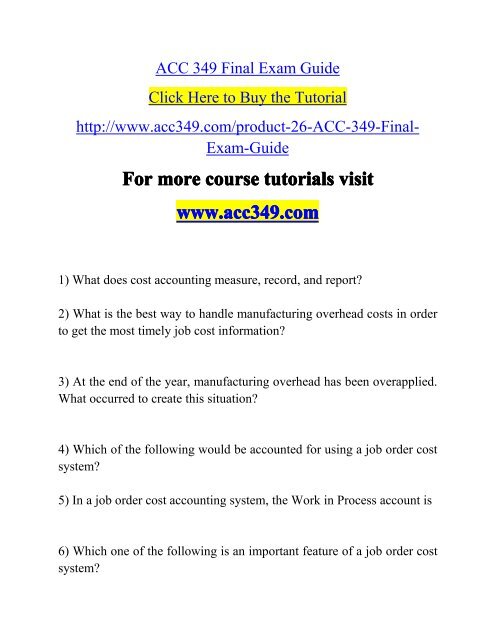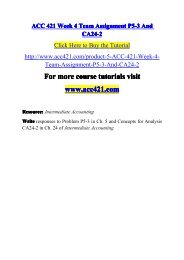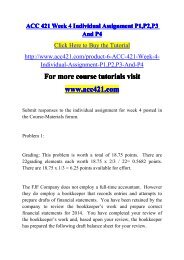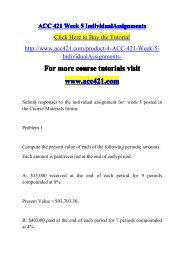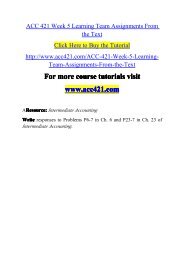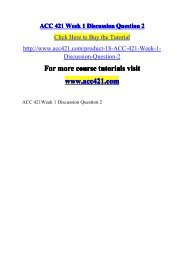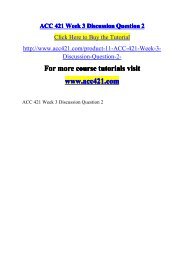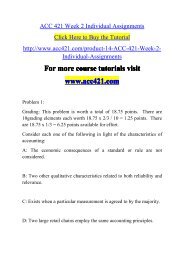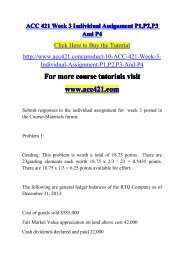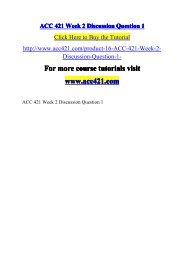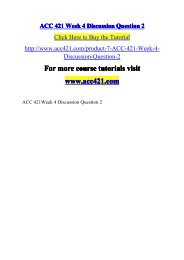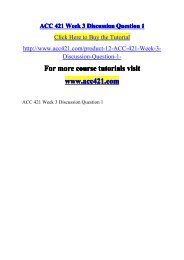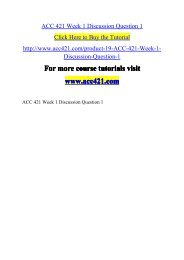ACC 349 Final Exam Guide-acc349dotcom
For more course tutorials visit www.acc349.com 1) What does cost accounting measure, record, and report? 2) What is the best way to handle manufacturing overhead costs in order to get the most timely job cost information? 3) At the end of the year, manufacturing overhead has been overapplied. What occurred to create this situation? 4) Which of the following would be accounted for using a job order cost system? 5) In a job order cost accounting system, the Work in Process account is 6) Which one of the following is an important feature of a job order cost system? 7) Which one of the following is indirect labor considered? 8) Which of the following is an element of manufacturing overhead? 9) Which one of the following costs would be included in manufacturing overhead of a lawn mower manufacturer? 10) A well-designed activity-based costing system starts with 11) An activity that has a direct cause-effect relationship with the resources consumed is a(n) 12) In traditional costing systems, overhead is generally applied based on 13) All of the following statements are correct EXCEPT that
For more course tutorials visit
www.acc349.com
1) What does cost accounting measure, record, and report?
2) What is the best way to handle manufacturing overhead costs in order to get the most timely job cost information?
3) At the end of the year, manufacturing overhead has been overapplied. What occurred to create this situation?
4) Which of the following would be accounted for using a job order cost system?
5) In a job order cost accounting system, the Work in Process account is
6) Which one of the following is an important feature of a job order cost system?
7) Which one of the following is indirect labor considered?
8) Which of the following is an element of manufacturing overhead?
9) Which one of the following costs would be included in manufacturing overhead of a lawn mower manufacturer?
10) A well-designed activity-based costing system starts with
11) An activity that has a direct cause-effect relationship with the resources consumed is a(n)
12) In traditional costing systems, overhead is generally applied based on
13) All of the following statements are correct EXCEPT that
You also want an ePaper? Increase the reach of your titles
YUMPU automatically turns print PDFs into web optimized ePapers that Google loves.
<strong>ACC</strong> <strong>349</strong> <strong>Final</strong> <strong>Exam</strong> <strong>Guide</strong><br />
Click Here to Buy the Tutorial<br />
http://www.acc<strong>349</strong>.com/product-26-<strong>ACC</strong>-<strong>349</strong>-<strong>Final</strong>-<br />
<strong>Exam</strong>-<strong>Guide</strong><br />
For more course tutorials visit<br />
www.acc<strong>349</strong>.com<br />
1) What does cost accounting measure, record, and report?<br />
2) What is the best way to handle manufacturing overhead costs in order<br />
to get the most timely job cost information?<br />
3) At the end of the year, manufacturing overhead has been overapplied.<br />
What occurred to create this situation?<br />
4) Which of the following would be accounted for using a job order cost<br />
system?<br />
5) In a job order cost accounting system, the Work in Process account is<br />
6) Which one of the following is an important feature of a job order cost<br />
system?
7) Which one of the following is indirect labor considered?<br />
8) Which of the following is an element of manufacturing overhead?<br />
9) Which one of the following costs would be included in manufacturing<br />
overhead of a lawn mower manufacturer?<br />
10) A well-designed activity-based costing system starts with<br />
11) An activity that has a direct cause-effect relationship with the<br />
resources consumed is a(n)<br />
12) In traditional costing systems, overhead is generally applied based<br />
on<br />
13) All of the following statements are correct EXCEPT that<br />
14) Which of the following is a value-added activity?<br />
15) Which of the following is a nonvalue-added activity?<br />
16) Poodle Company manufactures two products, Mini A and Maxi B.
Poodle's overhead costs consist of setting up machines, $800,000;<br />
machining, $1,800,000; and inspecting, $600,000. Information on the<br />
two products is:<br />
Mini A Maxi B<br />
Direct labor hours 15,000 25,000<br />
Machine setups 600 400<br />
Machine hours 24,000 26,000<br />
Inspections 800 700<br />
Overhead applied to Mini A using activity-based costing is<br />
17) Poodle Company manufactures two products, Mini A and Maxi B.<br />
Poodle's overhead costs consist of setting up machines, $800,000;<br />
machining, $1,800,000; and inspecting, $600,000. Information on the<br />
two products is:<br />
Mini A Maxi B<br />
Direct labor hours 15,000 25,000<br />
Machine setups 600 400<br />
Machine hours 24,000 26,000<br />
Inspections 800 700<br />
Overhead applied to Mini A using traditional costing using direct labor<br />
hours is
18) Which of the following factors would suggest a switch to activitybased<br />
costing?<br />
19) Rosen, Inc. has 10,000 obsolete calculators, which are carried in<br />
inventory at a cost of $20,000. If the calculators are scrapped, they can<br />
be sold for $1.10 each (for parts). If they are repackaged, at a cost of<br />
$15,000, they could be sold to toy stores for $2.50 per unit. What<br />
alternative should be chosen, and why?<br />
20) Walton, Inc. is unsure of whether to sell its product assembled or<br />
unassembled. The unit cost of the unassembled product is $16, while the<br />
cost of assembling each unit is estimated at $17. Unassembled units can<br />
be sold for $55, while assembled units could be sold for $71 per unit.<br />
What decision should Walton make?<br />
21) The cost to produce Part A was $10 per unit in 2005. During 2006, it<br />
has increased to $11 per unit. In 2006, Supplier Company has offered to<br />
supply Part A for $9 per unit. For the make-or-buy decision,<br />
22) Hess, Inc. sells a single product with a contribution margin of $12<br />
per unit and fixed costs of $74,400 and sales for the current year of<br />
$100,000. How much is Hess’s break-even point?<br />
23) Hartley, Inc. has one product with a selling price per unit of $200,<br />
the unit variable cost is $75, and the total monthly fixed costs are<br />
$300,000. How much is Hartley’s contribution margin ratio?
24) H55 Company sells two products, beer and wine. Beer has a 10<br />
percent profit margin and wine has a 12 percent profit margin. Beer has<br />
a 27 percent contribution margin and wine has a 25 percent contribution<br />
margin. If other factors are equal, which product should H55 push to<br />
customers?<br />
25) Which cost is charged to the product under variable costing?<br />
26) Which cost is NOT charged to the product under variable costing?<br />
27) Variable costing<br />
28) If a company is concerned with the potential negative effects of<br />
establishing standards, they should<br />
29) The difference between a budget and a standard is that<br />
30) A standard cost is<br />
31) The per-unit standards for direct labor are 2 direct labor hours at $12<br />
per hour. If in producing 2,400 units, the actual direct labor cost was<br />
$51,200 for 4,000 direct labor hours worked, the total direct labor<br />
variance is<br />
32) The total variance is $10,000. The total materials variance is $4,000.<br />
The total labor variance is twice the total overhead variance. What is the<br />
total overhead variance?
33) The per-unit standards for direct materials are 2 gallons at $4 per<br />
gallon. Last month, 11,200 gallons of direct materials that actually cost<br />
$42,400 were used to produce 6,000 units of product. The direct<br />
materials quantity variance for last month was<br />
34) If the standard hours allowed are less than the standard hours at<br />
normal capacity,<br />
35) Manufacturing overhead costs are applied to work in process on the<br />
basis of<br />
36) The overhead volume variance relates only to<br />
37) At January 1, 2004, Barry, Inc. has beginning inventory of 4,000<br />
widgets. Barry estimates it will sell 35,000 units during the first quarter<br />
of 2004 with a 10% increase in sales each quarter. Barry’s policy is to<br />
maintain an ending inventory equal to 25% of the next quarter’s sales.<br />
Each widget costs $1 and is sold for $1.50. How much is budgeted sales<br />
revenue for the third quarter of 2004?<br />
38) Lewis Hats is planning to sell 600 straw hats. Each hat requires a<br />
half pound of straw and a quarter hour of direct labor. Straw costs $0.20<br />
per pound and employees of the company are paid $22 per hour. Lewis<br />
has 80 pounds of straw and 40 hats in beginning inventory and wants to<br />
have 50 pounds of straw and 60 hats in ending inventory. How many<br />
units should Lewis Hats produce in April?
39) Gottberg Mugs is planning to sell 2,000 mugs and produce 2,200<br />
mugs during April. Each mug requires 2 pounds of resin and a half hour<br />
of direct labor. Resin costs $1 per pound and employees of the company<br />
are paid $12.50 per hour. Manufacturing overhead is applied at a rate of<br />
120% of direct labor costs. Gottberg has 2,000 pounds of resin in<br />
beginning inventory and wants to have 2,400 pounds in ending inventory.<br />
How much is the total amount of budgeted direct labor for April?<br />
40) The cost-plus pricing approach's major advantage is<br />
41) A company must price its product to cover its costs and earn a<br />
reasonable profit in<br />
42) Prices are set by the competitive market when


